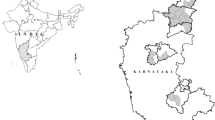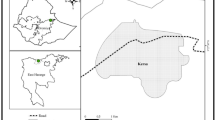Abstract
An effective evaluation of soil fertility can provide a theoretical basis for managing quality and strategies of fertilization for soil. Based on 32 m × 32 m grid sampling, the soil organic matter, total N, total P, total K, available K, available P, salinity and soil pH were used as the soil fertility evaluation factors. And we integrated evaluation of the soil fertility using classical statistics, geostatistics and modified Nemoro fertility index. The result shows that the mean value of pH was 8.89 which showed alkalinity. The CV for organic matter, total N, total K, pH and available K were low variation. Others (total P, available P and salinity) were moderate variation. The nugget variances for organic matter and total were strong spatial autocorrelation. Others were between 0.418 and 0.5, indicating moderate spatial autocorrelation. The spatial distribution of each fertility index was not obvious. The Ps was within the range of 0.63–0.80, all fertility indicators surrounding graphics areas were small in Radar map, indicating the fertility level was classified as barren. The mean fertility index, Pi, of the soil was in the order: available K > salinity > total K > available P > pH > total P > organic matter > total N. The soil organic matter and total N were the main limiting factors restraining soil fertility. The spatial distribution patterns of soil index and Ps were complicated and had no regularity with patch distribution at field scale. The methods of increasing organic fertilizers, crop rotation and fallow were practicable and necessary for soil fertilizing management, increasing yields and improving crop quality.





Similar content being viewed by others
References
Andrews SS, Karlen DL, Mitchell JP (2002) A comparison of soil quality indexing methods for vegetable production systems in northern California. Agric Ecosyst Environ 90(1):25–45
Bagherzadeh A, Gholizadeh A (2018) Assessment of soil fertility for sugar beet production using fuzzy AHP approach and GIS in the northeastern region of Iran. Agric Res 7(1):61–71
Bao SD (2005) Soil agricultural chemistry analysis, 3rd edn. China Agriculture Press, Bei**g
Bao YX, Xu MG, Lv FT et al (2012) Evaluation method on soil quality under long-term fertilization. Sci Agric Sin China 45(20):4197–4204
Gao HX (2005) Application of multivariate statistical analysis. Peking University Press, Bei**g
Guo L, Sun Z, Ouyang Z et al (2017) A comparison of soil quality evaluation methods for fluvisol along the lower Yellow River. CATENA 152:135–143
Goovaerts P (1997) Geostatistics for natural resources evaluation. Oxford University Press, New York, pp 125–258
Joãom S, Joséo P, Josér MDS et al (2010) Map** soil and pasture variability with an electromagnetic induction sensor. Comput Electron Agric 73(1):7–16
Jiang Y, Li L, Wu Y et al (2008) Temporal–spatial variability of soil quality in karst region: a case study of **aojiang watershed Yunnan. Environ Geol 55(4):875–887
Kan WJ, Wu QT (1994) Primary study on a quantitative method about comprehensive evaluating soil quality. Chin J Soil Sci 25(6):245–247
Li XY (2003) Gravel–sand mulch for soil and water conservation in the semiarid loess region of northwest China. CATENA 52(2):105–127
Marzaioli R, D’Ascoli R, De Pascale RA et al (2010) Soil quality in a Mediterranean area of Southern Italy as related to different land use types. Appl Soil Ecol 44:205–212
Mäder P, Fliessbach A, Dubois D et al (2002) Soil quality and biodiversity in organic farming. Science 296(5573):1694–1697
Nielsen DR, Bouma J (1985) Soil spatial variability. Pudoc, Wageningen
National Soil Survey Office Chinese Soils (1998) China soil. China Agriculture Press, Bei**g
Nie Y, Yu J, Peng Y et al (2016) A comprehensive evaluation of soil fertility of cultivated land: a GIS-based soil basic niche-fitness model. Commun Soil Sci Plant Anal 47(5):670–678
Qi YB, Darilek JL, Huang B et al (2009) Evaluating soil quality indices in an agricultural region of Jiangsu province, China. Geoderma 149(3):325–334
Qiu Y, **e ZK, Wang YJ et al (2015) Long-term effects of gravel-sand mulch on soil organic carbon and nitrogen in the Loess Plateau of northwestern China. J Arid Land 7(1):46–53
Rhoades JD, Manteghi NA, Shouse PJ et al (1989) Estimating soil salinity from saturated soil-paste electrical conductivity. Soil Sci Soc Am J 53:428–433
Rahmanipour F, Marzaioli R, Bahrami HA et al (2014) Assessment of soil quality indices in agricultural lands of Qazvin province, Iran. Ecol Indic 40(5):19–26
Swanepoel PA, Preez CCD, Botha PR et al (2014) Soil quality characteristics of kikuyu–ryegrass pastures in South Africa. Geoderma 232–234:589–599
Sione SMJ, Wilson MG, Lado M et al (2017) Evaluation of soil degradation produced by rice crop systems in a Vertisol, using a soil quality index. CATENA 150:79–86
Takoutsing B, Weber J, Aynekulu E et al (2016) Assessment of soil health indicators for sustainable production of maize in smallholder farming systems in the highlands of Cameroon. Geoderma 276:64–73
Wang JY, Wang C, Wang F et al (2015) Soil quality evaluation based on field scale in the gravel mulched field. Chin J Soil Sci 46(1):36–41
Zhao WJ, Cui Z, Zhou CQ et al (2017) Monitoring and predicting soil-clay content from soil-water content in a gravel-mulched field in northwestern China. J Hydrol Eng 22(12):05017025:1–05017025:7
Zhao WJ, Cui Z, Zhang JY et al (2017) Temporal stability and variability of soil-water content in a gravel-mulched field in northwestern China. J Hydrol 552:249–257
Zhao WJ, Sheng J, Li ZL et al (2017) Spatial variability of soil salinity in a gravel-sand mulched jujube orchard at different scales. J Irrig Drain Eng 143(6):04017009:1–04017009:8
Zhao WJ, Cui Z, Fan YW et al (2018) Predicting spatial variability of soil bulk density in gravel-mulched fields. J Hydrol Eng 23(6):04018022:1–04018022:9
Zhang SW, Huang YF, Shen CY et al (2012) Spatial prediction of soil organic matter using terrain indices and categorical variables as auxiliary information. Geoderma 171(2):35–43
Zhao Y, Li CJ, Kang JH et al (2009) Development of sandy field and application of research in Ningxia. J Agric Sci 30(2):35–38
Acknowledgements
The research was supported by National Natural Science Foundation of China (51869010), Ministry of Agriculture Open Fund Project (2017001) and Longyuan Youth Innovation and Entrepreneurship Project.
Author information
Authors and Affiliations
Corresponding author
Additional information
Publisher's Note
Springer Nature remains neutral with regard to jurisdictional claims in published maps and institutional affiliations.
Rights and permissions
About this article
Cite this article
Zhao, W., Luo, M., Li, Z. et al. Evaluation of Soil Fertility in a Gravel-Sand-Mulched Jujube (Ziziphus jujuba) Orchard Based on Modified Nemoro Fertility Indexing Method. Agric Res 9, 85–93 (2020). https://doi.org/10.1007/s40003-019-00408-8
Received:
Accepted:
Published:
Issue Date:
DOI: https://doi.org/10.1007/s40003-019-00408-8




